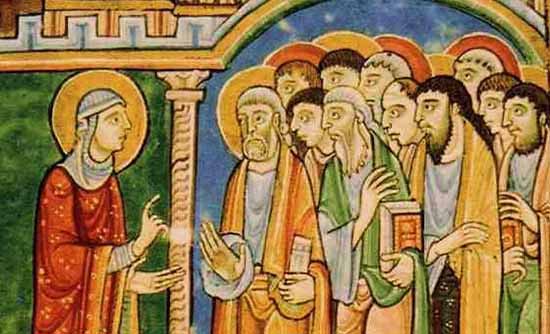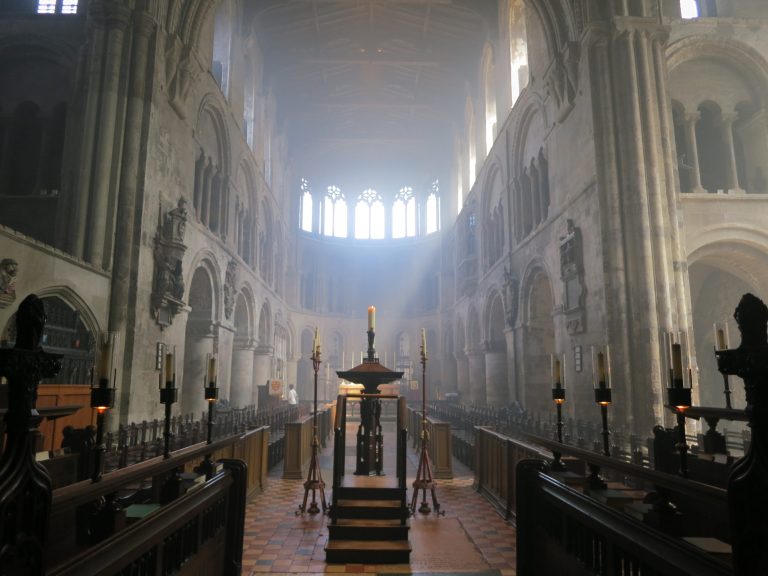The Gender Inclusive Bible Debate (Medieval Style)
I remember this so well. It was 1997–the year I graduated from college, the year I got married, and the year I started graduate school at the University of North Carolina at Chapel Hill. It was also the year that the world learned about Zondervan’s gender-neutral edition of the NIV (which eventually became known as the TNIV).
The uproar was instantaneous.
The TNIV was an intentionally gender inclusive language Bible–not in terms of language about God; just in terms of language about people. “Brothers and sisters” instead of “brothers,” etc. Wayne Grudem, then professor at Trinity Evangelical Divinity School and member of the Council for Biblical Manhood and Womanhood, scathingly reviewed the translation, writing that: “The heart of the controversy is this: The TNIV people have decided to translate the general idea of a passage and to erase the male-oriented details.” Grudem even accused the International Bible Society (IBS) as violating the International Forum of Bible Agencies translation guidelines with the publication of the TNIV. James Dobson, a leading voice among conservative evangelicals, also spoke against the TNIV, stating that he would “speak out against any effort that alters God’s Word or toys with translation methodology for the sake of ‘political correctness.’”
Indeed, Zondervan’s plans for a gender-neutral bible was countered just a few years later by the release of the English Standard Version in 2001 (the ESV). World Magazine explains how critics of “regendered language” began discussions to “resolve the inclusive NIV issue.” James Dobson called a meeting in May 1997; Wayne Grudem entered translation negotiations with Crossway and the National Council of Churches; and, in 1998, permission was secured to revise the 1971 Revised Standard Version (RSV) and release a new bible translation. The ESV was born.
As someone who studies late medieval English sermons, I find the controversy over the TNIV really amusing.
Long before either the TNIV or ESV (or even KJV, for that matter), some late medieval English priests had already erased “the male-oriented details” from their rendering of scripture within sermons: (1) when it was not critical to the point of a biblical passage and (2) when the scriptural message clearly applied to both sexes. That way, men and women in sermon audiences could relate better to the word of God.
I have three examples for you (from my recently published articles; although I have more examples forthcoming in my next book). It is important to note, however, that in late medieval England the Vulgate (Jerome’s Latin translation of the bible) and the English Wyclif Bible (as we call it today) were the primary scripture translations in circulation. Thus the gendered language changes I note draw from comparison with these two bibles.
John 6:44, as rendered by the Wyclif New Testatement, states: “No man may come to me: but if the father that sent me draw him.” A fifteenth-century sermon for the Second Sunday in Lent in Bodleian Library MS Greaves 54 adds the phrase “nor woman” into John 6:44: “that is to say, no man nor woman comes to me but my Father draw him.” This is significantly more gender inclusive than the KJV “no man can come…”, and even one step further than the modern gender attentive translations the TNIV (and interestingly the ESV also…) “no one can come…”. (Beth Allison Barr, “sche hungryd ryth sor aftyr Goddys word”: Female Piety and the Legacy of the Pastoral Programme in the Late Medieval English Sermons of Bodleian Library MS Greaves 54,” Journal of Religious History, 2015).
The Vulgate renders John 8:47 as, “He that is of God hears the words of God. Therfore you hear them not because you are not of God.” The Passion sermon in Bodleian Library MS Greaves 54 reorders and rephrases the text to make it more gender inclusive: “therefor ye hear not for ye be not of God…every man and woman that hath readied his heart to hear the word of God and keep it in working, he is of God.” (Beth Allison Barr, “he is Bothyn Modyr, Brother, & Syster Vn-To Me”: Women and the Bible in Late Medieval and Early Modern English Sermons,” Church History and Religious Culture 94, 2014).
A fifteenth-century sermon for the 17th Sunday after Trinity in the Dominican Sermon Cycle also scripts women into biblical text. The sermon first includes almost verbatim Luke 14:11 from the Wyclif New Testament: “For every man that exalts himself, he shall be lowered, and he that humbles himself, he shall be raised.” The sermon than addresses the “male-oriented details” and rewrites the verse: “For every man and woman that exalts himself in this sin of pride, he shall be made low.” (CHRC 94, 2014).
Since this was the fourteenth and fifteenth centuries, I guarantee the intentional inclusions of “woman,” “ye,” and “every man and woman,” had nothing to do with “political correctness” or hidden feminist agendas. Preachers were concerned that scripture teachings be taken to heart by all of their audience members, so they changed–sometimes obscuring–“the male-oriented details” for women. That way, both men and women could better hear the word of God.
It seems funny to me that, in regards to understanding the importance of gender inclusive language, late medieval English priests were more progressive than many modern evangelicals.




